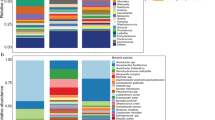Abstract
The carbon isotope ratio (δ13C) of New Zealand mistletoes (–29.51±0.10‰) and their hosts (–28.89±0.12‰) is generally more negative, and shows less difference between mistletoes and their hosts, than found in previous studies. In 37% of the examined pairs, the δ13C of mistletoes was less negative than that of their hosts. These reversals were not associated with the relative position (proximal or distal) of the host material with regard to the mistletoe. Differences between host and mistletoe tended to be greater on hosts with less negative δ13C. Both nitrogen content and isotope ratio (δ15N) of the mistletoe leaves were strongly correlated with those of their hosts. Nitrogen contents of mistletoe leaves were similar to those of their hosts at low nitrogen contents but proportionately less on hosts with a high nitrogen content, whereas δ15N of mistletoes was consistently similar to that of their hosts. The δ13C of mistletoes was related to both host nitrogen content and δ15N, but δ13C in host tissue was related to neither, suggesting that the mistletoes derived both nitrogen and carbon from their hosts. The δ13C of both hosts and mistletoes were significantly related to leaf conductance and carbon dioxide concentration but relationships with transpiration and water use efficiency were not significant. In all cases there was no clear separation between the responses of hosts and mistletoes. This may be related to the similarity of stomatal conductance, transpiration and photosynthesis in the studied mistletoes and their hosts and is consistent with the small differences in δ13C between mistletoes and hosts found in this study. Consequently, the estimation of mistletoe heterotrophy from carbon discrimination is confounded, as the small difference between host and mistletoe carbon discrimination could equally well result from either similarities in photosynthesis and water relations or heterotrophic assimilation of host-derived carbon. The differences between our study and previous studies (which are mostly from seasonally dry or semi-arid to arid environments) may be related to the temperate environment in which these mistletoes grow. Water is freely available so that the mistletoe is able to obtain sufficient water and dissolved nutrients without having to maintain the high transpiration rate and low water potentials that are needed to extract water from a water-stressed host. Similarly, mistletoe photosynthesis is less inhibited by water stress. The physiological similarities between mistletoe and hosts from a temperate environment are reflected in their similar δ13C values.
Similar content being viewed by others
Author information
Authors and Affiliations
Additional information
Electronic Publication
Rights and permissions
About this article
Cite this article
Bannister, P., Strong, G.L. Carbon and nitrogen isotope ratios, nitrogen content and heterotrophy in New Zealand mistletoes. Oecologia 126, 10–20 (2001). https://doi.org/10.1007/s004420000495
Received:
Accepted:
Published:
Issue Date:
DOI: https://doi.org/10.1007/s004420000495




